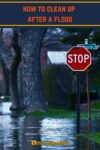Flooding is the most frequent natural disaster. While a 1% annual flood risk (1 in 100 year flood) may seem low, it actually means that there is a 25% chance that you’ll experience a flood within the timespan of a 30 year mortgage.
It doesn’t take much flood water to cause huge amounts of damage. Floodwater often contains sewage and other disease-causing microorganisms, so the damage can turn into a health nightmare.
The longer you wait to clean up after a flood, the worse the damage will be. Because of this, it’s incredibly important that you know how to clean up after a flood.
Flood Cleanup Supplies
When preparing for disasters, a lot of people focus on items like food and water. But it’s equally as important to have cleanup supplies on hand. For flood cleanup, you will need:
- Protective gear: Including long-sleeved shirts, long pants, plastic gloves, rubber boots, goggles and respirator masks.
- Bleach
- Biocides/mold killer
- Dish detergent
- Sponges, scrub brushes and rags
- Buckets
- Heavy-duty trash bags
- Hand tools
- Shovel
- Fans
Also read: Non-Food Disaster Supplies to Stockpile
How to Clean Up After a Flood
- Take photos. You will need these for insurance purposes.
- Wear protective gear. Remember that flood water contains many disease-causing organisms. You don’t want your skin to come in contact with these. Likewise, you don’t want to breathe in mold, building materials, or airborne contaminants.
- Open windows and doors in the area where you are working. If possible, leave them open when you leave.
- Remove soaked items. Put them in trash bags or plastic bins outside of your home.
- Throw away items that cannot be cleaned and dried within 24-48 hours. This includes many porous items such as carpets, pillows, mattresses, stuffed animal toys, and textiles.
- Shovel out dirt and silt. If possible, use a wet vacuum to remove any remaining debris.
- Open wall panels. Panel walls are very porous and can absorb water well above the floodwater line. You’ll need to open them up and remove insulation to facilitate fast drying. Discard any drywall or insulation which is contaminated with floodwater.
- Scrub all contaminated hard surfaces with water and dish detergent, such as flooring, wood doors, metal furniture, appliances and countertops. Rinse with clean water afterward.
- Use bleach to disinfect surfaces and items. For most items and surfaces, use 1 cup of bleach per 5 gallons of water. Use unscented household bleach with a sodium hypochlorite concentration between 5% and 9%. Allow the surfaces/items to air dry after disinfecting. If you have a fan and it is safe to use it (no electrical risks), turn it on to facilitate drying.
- Clean up mold. If mold starts to grow on surfaces, you’ll need to wash or scrub them with a mixture of 1 cup bleach to 1 gallon of water. Rinse with clean water and then allow to air dry.
Notes: Never mix bleach with ammonia cleaning products. When in doubt, throw it out. Leaving wet items in your home increases the chances of mold growth. Contact local officials for instructions on how to dispose of flood-contaminated items safely.
Flood Cleanup Instructions for Specific Items
Photographs
Stack wet photographs between sheets of wax paper and put them in a zip-lock bag. Freeze them to slow damage. You can defrost and air dry them later when you have time.
Books and Papers
Freeze in a sealed zip-lock bag until you have time to dry them. Then defrost and put blotting paper between pages to help them dry.
Clothing and Textiles
Shake out mud and hose down before putting them in the washing machine. Add 1 cup of bleach to the wash cycle. If the clothes cannot be washed with bleach, use a pine oil cleaner instead.
Canned Goods
Remove the labels from cans. Wash with warm, soapy water. Dip the cans in a mixture of 1 cup bleach per 5 gallons water. Allow to air dry and re-label the cans with permanent marker.
Non-porous food surfaces (counters, plates, utensils, etc.)
Wash with hot water and soap, rinse and then sanitize with a mixture of 1 Tbsp. bleach to 1 gallon of clean water. Allow to air dry.
Porous food surfaces
Throw away items like wooden cutting boards, baby bottles and nipples, pottery, and soft plastics which have touched floodwater.
Feather and foam rubber pillows
Machine wash pillows in the laundry machine with 1 cup of bleach added to the wash cycle. Only wash up to 2 pillows at a time. Use an extra rinse cycle. Dry in the dryer or hang to air dry.
Children’s toys
Non-porous toys can be cleaned with hot water and detergent and then disinfected with bleach solution (1 cup bleach to 5 gallons water). Soft toys and molded toys with injection holes should be discarded.
Important: Only use clean water for disinfecting. If a boil alert is in place, you will need to boil the water before mixing it with bleach.



1. If area gets wet, spray electrical outlets with WD40 to prevent internal corrosion
2. If you use a level or straight edge and mark the wallboard, you can make a neater cut with a circular saw which will make the repair neater and less expensive. Just breaking and pulling is messy and expensive.
3. When wallboard and wet insulation is removed, spray studs with anti fungicide to prevent mold buildup
4. Get yourself an outdoor enclosure to sleep in with netted sides to keep bugs out. At least you can take a nap or get some sleep if your house can’t be occupied.